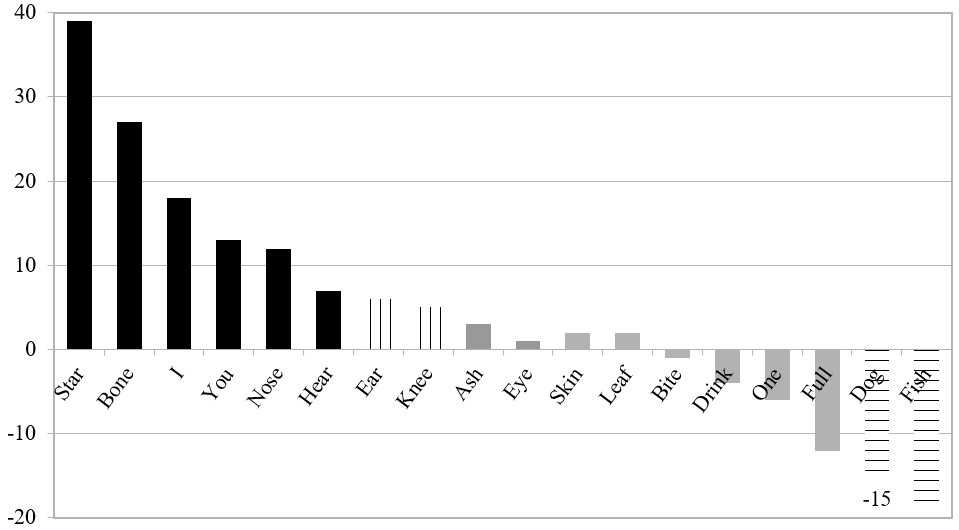An Experimental Verification of Some Cross-linguistic Sound Symbolisms
Abstract
A recent investigation of 6452 languages (Blasi et al., 2016) uncovered a number of cross-linguistic correspondences between speech sounds and meaning. For example, the phone [z] was associated with the meaning ‘star.’ In the present study, 16 of these sound symbolisms were tested by presenting English and Spanish speakers with pairs of nonce words along with a definition of the words. Their task was to choose the word that sounded best with the meaning given. One member of the pair of words contained phones found to be associated with the meaning of the word while the other did not. For instance, participants were asked to choose between [zolz] and [folf] as the word they felt was most likely to mean ‘star. ‘ Seven of the sound and meaning correspondences observed in the study by Blasi et al. (2016) were corroborated by both Spanish and English speakers. Three additional sound correspondences were only significant in one of the experimental languages.
Downloads
References
Asano, M., & Yokosawa, K. (2011). Synesthetic colors are elicited by sound quality in Japanese synesthetes. Consciousness and Cognition, 20(4), 1816-1823. https://doi.org/10.1016/j.concog.2011.05.012
Bergen, B. K. (2004). The psychological reality of phonaesthemes. Language, 80(2), 290-311. https://doi:10.1353/lan.2004.0056.
Berlin, B. (1994). Evidence for pervasive synesthetic sound symbolism in ethnozoological nomenclature. Sound symbolism, 76-93. https://10.1017/CBO9780511751806.006
Blasi, D. E., Wichmann, S., Hammarström, H., Stadler, P. F., & Christiansen, M. H. (2016). Sound–meaning association biases evidenced across thousands of languages. Proceedings of the National Academy of Sciences, 113(39), 10818-10823. https://doi.org/10.1073/pnas.1605782113
Bolinger, D. L. (1950). Rime, assonance, and morpheme analysis. Word, 6(2), 117-136. https://doi.org/10.1080/00437956.1950.11659374
Brown, R. W., Black, A. H., & Horowitz, A. E. (1955). Phonetic symbolism in natural languages. The Journal of Abnormal and Social Psychology, 50(3), 388. https://doi.org/10.1037/h0046820
Cuskley, C. (2013). Mappings between linguistic sound and motion. Public Journal of Semiotics, 5(1), 39-62.
https://doi.org/10.37693/pjos.2013.5.9651
Dingemanse, M. (2012). Advances in the cross‐linguistic study of ideophones. Language and Linguistics compass, 6(10), 654-672. https://doi.org/10.1002/lnc3.361
Dingemanse, M., Blasi, D. E., Lupyan, G., Christiansen, M. H., & Monaghan, P. (2015). Arbitrariness, iconicity, and systematicity in language. Trends in cognitive sciences, 19(10), 603-615. https://doi.org/10.1016/j.tics.2015.07.013
D’Onofrio, A. (2014). Phonetic detail and dimensionality in sound-shape correspondences: Refining the bouba-kiki paradigm. Language and Speech, 57(3), 367-393. https://doi.org/10.1177/0023830913507694
Eddington, D. E., & Nuckolls, J. (2019). Examination of manner of motion sound symbolism for English nonce verbs. Languages, 4(4), 85. https://doi.org/10.3390/languages4040085
Firth, J. R. (1930). Speech 1930 London: Benn's Sixpenny Library.
Hinton, L., Nichols, J., & Ohala, J. J. (Eds.). (2006). Sound symbolism. Cambridge University Press.
Imai, M., & Kita, S. (2014). The sound symbolism bootstrapping hypothesis for language acquisition and language evolution. Philosophical transactions of the Royal Society B: Biological sciences, 369(1651), 20130298. https://doi.org/10.1098/rstb.2013.0298
Joo, I. (2020). Phonosemantic biases found in Leipzig-Jakarta lists of 66 languages. Linguistic Typology, 24(1), 1-12. https://doi.org/10.1515/lingty-2019-0030
Jurafsky, D. (2014). The language of food: A linguist reads the menu. WW Norton & Company.
Köhler, W. (1970). Gestalt psychology: An introduction to new concepts in modern psychology (Vol. 18). WW Norton & Company.
Mompean, J. A., Fregier, A., & Valenzuela, J. (2020). Iconicity and systematicity in phonaesthemes: A cross-linguistic study. Cognitive Linguistics, 31(3), 515-548. https://doi.org/10.1515/cog-2018-0079
Moos, A., Smith, R., Miller, S. R., & Simmons, D. R. (2014). Cross-modal associations in synaesthesia: Vowel colours in the ear of the beholder. I-Perception, 5(2), 132-142. https://doi.org/10.1068/i0626
Newman, S. S. (1933). Further experiments in phonetic symbolism. The American Journal of Psychology, 45(1), 53-75. https://doi.org/10.2307/1414186
Nuckolls, J. B. (1999). The case for sound symbolism. Annual review of anthropology, 28(1), 225-252. https://doi.org/10.1146/annurev.anthro.28.1.225
de Saussure, F. (1916/1972). Course in general linguistics. Peru, Illinois: Open Court Publishing Company.
Ohala, J. J. (1983). The origin of sound patterns in vocal tract constraints. In The production of speech (pp. 189-216). Springer, New York, NY. https://doi.org/10.1007/978-1-4613-8202-7_9
Ohala, J. J. (1994). The frequency code underlies the sound-symbolic use of voice pitch. Sound symbolism, 2, 325-347. https://doi.org/10.1017/CBO9780511751806.022
Ramachandran, V. S., & Hubbard, E. M. (2001). Synaesthesia--a window into perception, thought and language. Journal of consciousness studies, 8(12), 3-34.
Saji, N., Akita, K., Kantartzis, K., Kita, S., & Imai, M. (2019). Cross-linguistically shared and language-specific sound symbolism in novel words elicited by locomotion videos in Japanese and English. PloS one, 14(7), e0218707. https://doi.org/10.1371/journal.pone.0218707
Saji, N., Akita, K., Imai, M., Kantartzis, K., & Kita, S. (2013). Cross-linguistically shared and language-specific sound symbolism for motion: An exploratory data mining approach. In Proceedings of the Annual Meeting of the Cognitive Science Society (Vol. 35, No. 35). https://doi.org/10.1371/journal.pone.0218707
Sapir, E. (1929). A study in phonetic symbolism. Journal of experimental psychology, 12(3), 225. https://doi.org/10.1037/h0070931
Schmidtke, D., Conrad, M., & Jacobs, A. M. (2014). Phonological iconicity. Frontiers in psychology, 5, 80. https://doi.org/10.3389/fpsyg.2014.00080
Taylor, I. K., & Taylor, M. M. (1965). Another look at phonetic symbolism. Psychological bulletin, 64(6), 413. https://doi.org/10.1037/h0022737


This work is licensed under a Creative Commons Attribution 4.0 International License.
Copyright for this article is retained by the author(s), with first publication rights granted to the journal.
This is an open-access article distributed under the terms and conditions of the Creative Commons Attribution license (http://creativecommons.org/licenses/by/4.0/).









1.png)









1.png)











